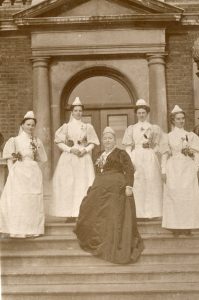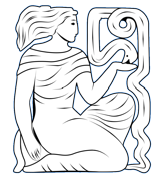| Sarah Rogers , Independent Researcher |
The UKAHN Bulletin |
| Volume 10 (1) 2022 | |
In October 1981 when I started my training at The London Hospital, Whitechapel, in London’s East End, we all lived in the Lückes Home. I cannot recall knowing anything about Eva Lückes and her relevance and significance, to either ‘The London’ or the wider nursing profession. Four decades later, and after many years immersed in Lückes, ‘The London’ and all the matrons whom I have identified that she ‘produced’, I have successfully finished my PhD thesis entitled ‘A Maker of Matrons’? A study of Eva Lückes’s influence on a generation of nurse leaders; 1880–1919’. Eva Charlotte Ellis Lückes (1854–1919), initially trained as ‘lady’ / paying probationer for three months at The Middlesex Hospital in September 1876. After a short rest because of illness, she completed one year’s training at The Westminster Hospital in August 1878, this time as a regular probationer. After short spells at ‘The London’, Pendlebury Hospital, Manchester and Great Ormond Street Hospital, Lückes was appointed as Matron at ‘The London’, the largest hospital in England, in October 1880 aged only 26.
Whilst I was training, I never imagined that I would end up researching Lückes. After qualifying I worked at ‘The London’ before moving into community nursing and nursed in many areas of Tower Hamlets, including Brick Lane and Poplar. After a stint as a Macmillan funded Community Hospice Sister in Brighton I moved to Kent and went back to District Nursing. Following a serious life-threatening illness which required emergency surgery and chemotherapy, I was retired on an ill-health pension. I felt bereft – losing the job I loved as a District Nurse was like a bereavement. A few years later I retrained as a Genealogist, taking tentative steps on a distance learning degree programme with the University of Dundee. As part of my dissertation for my MLitt in Family and Local History I studied the nurses who worked in the 1897 Maidstone typhoid epidemic. I became reacquainted with my nursing roots and I found that Lückes had sent several nurses from ‘The London’ to Maidstone, to work in the epidemic. Furthermore, many more ‘Londoners’ who were working elsewhere – often for nursing co-operatives – volunteered to work in the epidemic. So, my interest with Lückes began. I was intrigued by the concept that she was known as a ‘matron maker’ and referred to by her friend and mentor Florence Nightgale as ‘O Matron of Matrons’ and wondered what foundation there was in this nickname.

During my PhD research I established that Lückes was indeed a ‘matron maker’, and that she ‘made’ at least 474 future nursing leaders, through her own style of ‘Nightingale’ reformed nursing. Lückes was matron of ‘The London’ during the second wave, secular and ‘mothering phase’ of nursing reforms which ran from the 1880s until 1919 when the Nurses’ Registration Act was passed. During this period reformers were trying to modernise the profession, make it more respectable and move away from the ‘Sarah Gamp’ image of nursing. I suggest that Lückes used her selection and training process to produce genteel ladylike nurses with ‘tone’. She used the parental occupation of her future probationers as an indicator of their social class or background and education, and whether or not they had typical Victorian middle-class womanly characteristics, including: gentility, selflessness, punctuality, discipline, morality and obedience. Lückes’s training programme focused on ensuring that her nurses had the right characteristics, as well as a thorough technical education. If she thought they were deficient in particular characteristics’ she endeavoured to ‘correct’ them. Having produced her nurses Lückes identified a number who had special managerial potential and fast-tracked them, either during or after their training. Lückes was mentored by Florence Nightingale, and my research found that she utilised mentoring, patronage and networking to disseminate her reformed nursing diaspora at home and abroad. Lückes was particularly influential at sending her nurses to ‘failing’ hospitals, either on their own as a matron, or as part of a larger team of ‘Londoners’. For example, ‘Londoners’ went to several voluntary hospitals including The Metropolitan Hospital, Hackney, and the Royal Orthopaedic Hospital, London, and to a number of Poor Law infirmaries including West Ham (later Whipps Cross) and Bethnal Green.
However, I argue that her biggest influence was behind the scenes in the development of the Queen Alexandra’s Imperial Military Nursing Service from 1902 onwards. By 1915 three ‘Londoners’ were Matrons-in-Chief and occupied half of the top positions in Military Nursing: Dames Ethel Hope Becher, Emma ‘Maud’ McCarthy and Sarah Elizabeth Oram. In July 1919, and just a few months after Lückes’s death, Becher and Oram led the nursing contingent in the Peace Parade through London. That ‘Londoners’ attained key posts in both military and civilian nursing was commented on by Mrs Bedford Fenwick. Fenwick credited Sydney Holland (The London Hospital Chairman from 1896 onwards) with these successful appointments. She argued that they had been gained through his ‘unfair’ use of power and privilege from the social élite. Lückes and Holland developed a symbiotic relationship, which opened up networks and patronages and contributed to Lückes’s success as a ‘matron maker’.
Although Fenwick was a former ward sister under Lückes for a few months, before becoming Matron of St Bartholomew’s Hospital, 1880–1887, their views about the professionalisation of nursing remained diametrically opposed for over thirty years. Unlike Fenwick, and almost all other matrons in London by 1900, Lückes steadfastly refused to increase nurse training from two to three years. She also disagreed with Fenwick over the need for centralised State Registration for nurses. Therefore, it seems highly unlikely that either woman associated Fenwick as being a ‘Londoner’.

My study adds nuance to the debate about Lückes’s tenure as matron at ‘The London’. She is often remembered for her pioneering developments in nursing including the introduction of the first Preliminary Training School in England in 1895, her programme of education and lectures, improvements to nurses’ terms and conditions and her text books. However, Lückes is also remembered for her ‘sweating of nurses’ as examined in the 1890 Metropolitan Hospitals Enquiry, her opposition to a centralised mandatory state registration system and three-year training programme, and the College of Nursing. Lückes’s contribution, has to date, largely not been fairly represented by historians of nursing, whom have focussed on Nightingale, and to a lesser extent Fenwick. I believe that my research redresses the balance and suggests that Lückes also played an important role in extending reformed nursing.
I am deeply indebted to a member of the Royal London Hospital League of Nurses who was my personal tutor whilst I was a student nurse, for her encouragement of my growing interest in nursing history and my doctoral research, and I am very grateful to members of the League for their interest, support and encouragement. My academic development was nurtured by friends both in the Royal College of Nursing’s, History of Nursing Forum, and in UKAHN, and of course, my amazing supervisors Professors Christine Hallett and Janet Hargreaves.
As a ‘Londoner’ said (paraphrasing Carl Sagan’s famous quote), ‘if you don’t understand history, you don’t understand the present’ (‘Louise’– cited in Nursing Through The Years, Bellman et al, 2018, xvi. Please note that the names of the participants in this oral history project were anonymised). Studying Lückes and her influence has given me a far deeper appreciation of how our profession developed into what it is today. I have so enjoyed this challenge, and after a rest, I plan to start writing up Lückes’s biography, and perhaps research another nurse or two…
